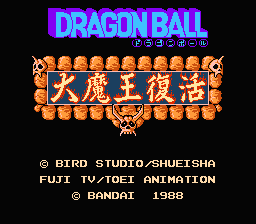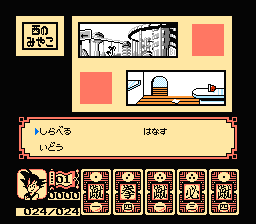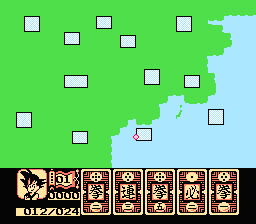Retro Replay Review
Gameplay
Dragon Ball: Daimaō Fukkatsu introduces a unique card-based RPG system that sets it apart from conventional action or platform titles of its era. Instead of direct character control, players navigate Son Goku through a grid of squares by selecting numbered movement cards displayed at the bottom of the screen. Each card corresponds to a specific number of steps, requiring strategic planning to reach events, towns, or training grounds efficiently. This design turns exploration into a tactical puzzle, where card management becomes as important as choosing your path.
Combat encounters follow a similar card-centric approach, blending offense and defense into a turn-based duel. During battles, you choose attack cards to deal damage or defensive cards to block incoming blows, with each card’s effectiveness influenced by Goku’s stats and enemy resistances. This card system adds a layer of unpredictability—drawing stronger cards can turn the tide, but runs of weaker draws can frustrate progress. Mastering the ebb and flow of card luck versus strategy is key to overcoming tougher foes like Ranfan, the Bull Demon, and ultimately Piccolo Daimaō.
The game also features classic Japanese adventure elements, allowing players to interact with NPCs, collect items, and solve simple puzzles. Visiting Master Roshi’s Temple for training sessions rewards you with stat boosts, new cards, or healing items, encouraging regular detours off the main path. Side quests in various locations, such as the perilous mountain shrine or the hidden Herb Village, offer both narrative depth and practical benefits, further enriching the RPG experience.
While the card system is innovative, it can slow down pacing, especially if you must shuffle through low-value cards repeatedly. Some players may find the reliance on chance a barrier to fluid progression, but others will appreciate the strategic tension it introduces. Overall, the gameplay strikes a memorable balance between board-game planning and classic role-playing mechanics, making every decision feel meaningful.
Graphics
On the graphical front, Dragon Ball: Daimaō Fukkatsu captures the spirit of Akira Toriyama’s designs within the limitations of the Famicom hardware. Character sprites are instantly recognizable—Goku’s spiky hair, Krillin’s bald head, and Piccolo Daimaō’s menacing silhouette all translate faithfully into pixel art. Towns, temples, and wilderness areas are rendered with simple but charming tile-based backgrounds that evoke the manga’s adventurous ambiance.
Animations in both travel and battle sequences are minimalist yet effective. Movement across the grid is represented by smooth sprite sliding, while attack and defense actions during fights trigger quick frame changes to convey impact. Though there’s no sweeping animation like in later Dragon Ball titles, each punch or energy blast feels weighty thanks to sound cues and screen shakes. The card interface itself is cleanly designed—distinct icons and numbers ensure you always know which options are available.
Color usage is limited to the NES palette, but the developers make smart choices to differentiate areas and characters. Villages feature earth tones, while dungeons and battlefields adopt darker hues, reinforcing the mood. Piccolo Daimaō’s lair stands out with contrasting reds and blacks, heightening the sense of danger. Though the visuals lack the polish of modern releases, they offer a nostalgic charm that will resonate with longtime Dragon Ball fans and retro gamers alike.
On the downside, environmental variety can feel repetitive after extended play. Overworld sections reuse tilesets, and some dungeon layouts are maze-like without much visual distinction. However, the art style’s consistency and faithful character portraits more than compensate, delivering a cohesive world that honors its source material.
Story
The narrative of Daimaō Fukkatsu picks up from the aftermath of the World Martial Arts Tournament, where Krillin is found dead under mysterious circumstances. With a demon’s symbol engraved on a note beside his body, the stakes are high from the very beginning. Master Roshi’s revelation that Piccolo Daimaō has returned to Earth frames the adventure as a race against time—Goku must not only defeat the evil demon but also gather the Dragon Balls to revive his fallen friend.
This adaptation remains surprisingly faithful to the original manga arc, albeit condensed to fit the game’s scope. Key moments—such as Goku’s emotional reaction to Krillin’s death, his tense confrontation with Ranfan, and eventual showdown with Piccolo—are all present in abbreviated form. Dialogue is text-heavy, delivered through on-screen message boxes, and while the game never matches the emotional depth of the anime, it effectively captures the sense of urgency and heroic determination that define Dragon Ball’s early chapters.
Character interactions are a highlight, with familiar faces like Oolong, Yamcha, and Master Roshi providing guidance, comic relief, or training opportunities. Minor narrative detours—such as negotiating with a forest hermit for healing herbs—enhance world-building and give side quests narrative weight. Although the story is straightforward, it remains engaging thanks to its iconic source material and the player’s personal investment in rescuing Krillin and thwarting Piccolo’s world-domination plans.
One drawback for non-Japanese speakers is the lack of official localization. Without fan translations, the text-heavy storytelling can be inaccessible to many players. Nevertheless, those who persevere will find a classic Dragon Ball tale that laid the groundwork for future RPG installments in the franchise.
Overall Experience
Dragon Ball: Daimaō Fukkatsu offers a nostalgic trip to the franchise’s roots, combining board-game-like exploration with RPG battles in a way that was groundbreaking for its time. The card-based mechanics provide a fresh twist on movement and combat, ensuring that no two play sessions feel identical due to the element of chance in card draws. For retro enthusiasts and die-hard Dragon Ball fans, this title remains a fascinating piece of franchise history worth exploring.
That said, modern players accustomed to more streamlined RPGs might find the pacing slow and the randomness of the card system occasionally frustrating. The graphical presentation, while charming, is limited by the hardware, and the repetitiveness of certain overworld tiles can detract from the immersion. Yet, these drawbacks are balanced by the game’s solid design, memorable story beats, and the joy of reliving Goku’s first epic confrontation with Piccolo Daimaō.
Replay value hinges on a player’s fondness for the Dragon Ball universe and tolerance for vintage game mechanics. Secondary objectives like maxing out stats through repeated training sessions, or seeking out hidden items in remote locations, offer additional challenges for completionists. Experienced RPG players will appreciate the strategic demands of card management, while newcomers may find the learning curve steep but ultimately rewarding.
In conclusion, Dragon Ball: Daimaō Fukkatsu stands as a unique and historically significant title. Its innovative gameplay and faithful storytelling make it an engaging purchase for collectors and franchise aficionados. While it may not hold up to modern standards in every respect, its nostalgic charm and inventive mechanics ensure it remains a memorable chapter in Dragon Ball’s long legacy.
 Retro Replay Retro Replay gaming reviews, news, emulation, geek stuff and more!
Retro Replay Retro Replay gaming reviews, news, emulation, geek stuff and more!









Reviews
There are no reviews yet.